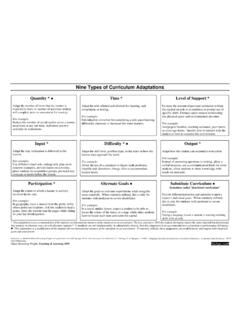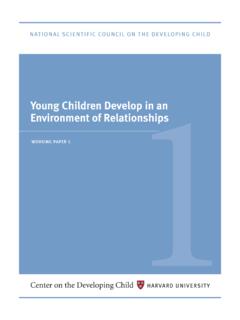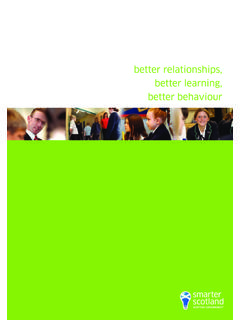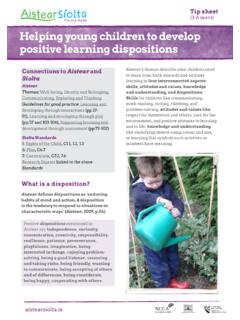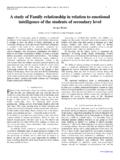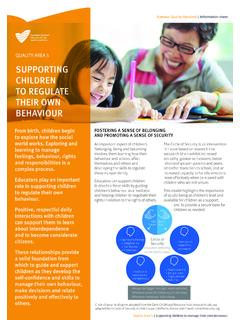Transcription of SNIP Training Toolkit Part 6 Let’s Play: Activities that ...
1 SNIP Training Toolkit Part 6. Let's Play: Activities that Strengthen Peer Relationships 5/17/2013. Let's Play! Activities that Strengthen Peer Relationships Many children need more than unstructured free time to master social skills. They also need guidance about which social behaviors to emulate. One way we can help children to learn and develop social skills is by using interactive games. Kids learn best when allowed to apply and practice what they're taught in a playful, non- threatening environment. Incorporating games into lessons is an excellent way to do that. What are important skills for children to master?
2 Research shows us that children with Cooperation, Participation, Validation/Support, Sportsmanship, and Conflict Resolution skills have an easier time making and keeping friends. Some examples of skills that fall within these categories are: COOPERATION VALIDATION - SUPPORT (Friendly-Fun-and-Nice). - Turn-taking - Giving positive attention to another person - Sharing toys/materials - Giving compliments. - Considering multiple perspectives - Smiling - Negotiating compromise - Having an awareness of other's feelings - Offering support or suggestions to a friend who PARTICIPATION has a problem - Staying with the group - Following directions SPORTSMANSHIP.
3 - Joining play - Congratulating the winner - Paying attention to the game or activity - Shaking hands and saying, Good game.". - Waiting - Knowing what to do when you make a mistake - Cheering for everyone on your team COMMUNICATION - Supporting the team with your attention - Saying what you mean - Maintaining composure when you lose -Understanding what someone has told you - Making appropriate observations and comments KEEPING YOUR COOL. - Asking appropriate questions - Grinning - Active listening - Making a joke - Noticing and interpreting facial expressions and - Keeping your voice calm and quiet body language - Expressing anger and frustration appropriately - Sharing humor - Self Regulation - Making and responding to requests - Self-Reflection Processes Many children naturally gain these skills as they mature.
4 While children develop at their own pace, which may differ slightly from child to child, we know that relationships with consistent, caring adults as well as access to early experiences and environments that allow children to practice these emerging skills can go a long way towards encouraging their positive social emotional development. The following are a number of Activities that promote important social skills: from giving compliments and staying in line to negotiating a compromise with peers, and helping out a friend in need. 1. Friendship Pie This idea is from the book, Including One Including All by Leslie Roffman and Todd Wanerman.
5 They created a system of including children with special needs into their program that is relationship based. The children and teachers decided on some kind ways they wanted to treat each other. They listed those ways on the outside of the pie: *Say yes and welcome friends to play *share *Keep everyone safe, their bodies and their feelings *Help each other-friends & teachers *Give compliments, or put ups vs. put downs, say nice things They put a sticker on the compliment pie every time someone acted in one of the agreed upon ways. When they got to 100 stickers they had a dance party. Materials Needed: Large paper or Poster-board, Markers, Stickers Time it Takes: Initial activity 30 minutes, then ongoing Skills This Builds: COOPERATION, PARTICIPATION, COMMUNICATION, VALIDATION - SUPPORT, SPORTSMANSHIP, KEEPING YOUR COOL (It depends on which kind friendship behaviors you decide to focus on.)
6 Ages: Pre-K through Elementary Hints for Modifying: Use pictures representing the actions in addition to text. Keep the skills simple/more concrete for younger children . For older or more socially advanced children you can use more advanced/abstract friendship behaviors and stars or check marks instead of stickers. 2. Guess the Feeling Identifying and Responding to Emotions People who are good at interpreting facial expressions can better anticipate what others will do and how to interact with them. They are also more pro-social, or helpful towards others. This game allows children to work on the social skills of empathy, self expression and reading body language.
7 Like classic charades, this game gives children the opportunity to use social skills such as perspective-taking and reading body language. Part I: Players draw slips of paper with emotions written on them (or pictures of expressions portraying emotions) from a container, and try conveying without using any words or sounds--the chosen word to their classmates. The rest of the kids must guess the emotion being portrayed. Aside from using non-verbal communication skills, kids converge and interact socially as they try guessing the word correctly. Part II: Once someone has guessed the correct emotion, choose a student to approach the charades actor and react appropriately to the emotion being portrayed.
8 As the actor and reactor leave the stage, encourage the other students to compliment and high-five them. Walk students through the steps of the game first and model the first round. Materials Needed: Feelings Flashcards (photographs of people making different facial expressions). Ideally, try to use multiple models for each emotion. Your collection should include expressions of: happy, sad, scared, angry, disgusted, and surprised as well as other emotions you know your students may be dealing with. Alternately, you can use feeling names written out on scraps of paper. Time it Takes: 15-30 minutes or the amount of time you have.
9 Skills This Builds: COOPERATION, PARTICIPATION, COMMUNICATION, VALIDATION - SUPPORT, SPORTSMANSHIP, KEEPING YOUR COOL. Ages: Pre-K through Elementary Hints for Modifying: As you are teaching Part II of the game, model the appropriate response first or brainstorm options as a class before the chosen student approaches the charades actor. Use lanyards/name tags that the students wear to delineate the roles (actor, reactor). 3. Feelings Matching Here's a game that can be played individually or as a group. The idea is to match each facial expression card with a situation that might evoke the emotion. For the game to work, you'll need to create a second set of cards, each depicting an emotion-evoking situation.
10 The images can come from a number of sources. If you're artistic, you can draw your own. Alternatively, stage and photograph "live" scenarios. Using your students as models can be a very effective way of engaging them in the game, or use free photos or clip art you can find on the web. Whichever approach you take, make sure the action in the picture is easy to interpret. Here are some ideas for scenarios: A person receiving a gift Someone running from a threat A foot being stepped on An ice cream cone that has fallen on the ground (rendering it inedible). A tower created from toy blocks being kicked over A child sharing A person receiving a high-five A person being snubbed or ignored by others Some situation cards may evoke multiple emotions.
